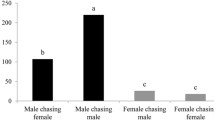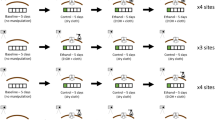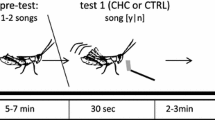Abstract
Animal courtship rituals are important for species recognition, and a variety of cues might be utilized to recognize conspecific mates. In this paper, we investigate different species-recognition mechanisms between two sympatric butterfly sister species: the wood white (Leptidea sinapis) and Real’s wood white (Leptidea reali). We show that males of both species frequently court heterospecific females both under laboratory and field conditions. The long-lasting elaborate courtships impose energetic costs, since the second courtship of males that were introduced to two subsequent conspecific females lasted on average only one fourth as long as the first courtship. In this paper, we demonstrate that premating reproductive isolation is dependent on female unwillingness to accept heterospecific mates. We studied female and male courtship behavior, chemical signaling, and the morphology of the sexually dimorphic antennae, one of the few male traits visible for females during courtship. We found no differences in ultraviolet (UV) reflectance and only small differences in longer wavelengths and brightness, significant between-species differences, but strongly overlapping distributions of male L. sinapis and L. reali antennal morphology and chemical signals and minor differences in courtship behavior. The lack of clear-cut between-species differences further explains the lack of male species recognition, and the overall similarity might have caused the long-lasting elaborate courtships, if females need prolonged male courtships to distinguish between con- and heterospecific suitors.









Similar content being viewed by others
References
Amiet JL (2004) Ecological niche partitioning between two sympatric sibling Leptidea species (Lepidoptera, Pieridae). Rev Ecol (Terre Vie) 59:433–452
Andersson J, Borg-Karlson AK, Wiklund C (2003) Antiaphrodisiacs in pierid butterflies: a theme with variation!. J Chem Ecol 29:1489–1499
Andersson J, Borg-Karlson AK, Vongvanich N, Wiklund C (2007) Male sex pheromone release and female mate choice in a butterfly. J Exp Biol 210:964–970
Andersson M (1994) Sexual selection. Princeton University Press, Princeton, New Jersey
Arnqvist G, Rowe L (2005) Sexual conflict. Princeton University Press, Princeton, New Jersey
Beneš J, Konvika M, Vrabec V, Zámečník J (2003) Do the sibling species of small whites, Leptidea sinapis and L. reali (Lepidoptera, Pieridae) differ in habitat preferences. Biol Brat 58:943–951
Brunton CFA (1998) The evolution of ultraviolet patterns in European Colias butterflies (Lepidoptera, Pieridae): a phylogeny using mitochondrial DNA. Heredity 80:611–616
Butlin RK (1995) Reinforcement—an idea evolving. Trends Ecol Evol 10:432–434
Costanzo K, Monteiro A (2007) The use of chemical and visual cues in female choice in the butterfly Bicyclus anynana. Proc R Soc Lond, B 274:845–851
Coyne JA, Orr HA (1997) ‘Patterns of speciation in Drosophila’ revisited. Evolution 51:295–303
Dieckmann U, Doebeli M (2004) Adaptive dynamics of speciation: sexual populations. In: Dieckmann U, Doebeli M, Metz JAJ, Tautz D (eds) Adaptive speciation. CambridgeUniversity Press, Cambridge, UK, pp 76–111
Eliasson CU, Ryrholm N, Holmer M, Jilg K, Gärdenfors U (2005) Nationalnyckeln till Sveriges flora och fauna Fjärilar: Dagfjärilar Hesperiidae-Nymphalidae. Uppsala, Sweden: Artdatabanken SLU
Fordyce JA, Nice CC, Forister M, Shapiro AM (2002) The significance of wing pattern diversity in the Lycaenidae: mate discrimination by two recently diverged species. J Evol Biol 15:871–879
Forsberg J, Wiklund C (1989) Mating in the afternoon—time-saving in courtship and remating by females of a polyandrous butterfly Pieris napi L. Behav Ecol Sociobiol 25:349–356
Freese A, Fiedler K (2002) Experimental evidence for species distinctness of the two wood white butterfly taxa, Leptidea sinapis and L. reali (Pieridae). Nota lepid 25:39–59
Friberg M, Bergman M, Kullberg J, Wahlberg N, Wiklund C (2007) Niche separation in space and time between two sympatric sister species—a case of ecological pleiotropy. Evol Ecol doi:10.1007/s10682-007-9155-y
Gavrilets S (2003) Models of speciation: What have we learned in 40 years? Evolution 57:2197–2215
Gwynne DT (1991) Sexual competition among females: What causes courtship-role reversal? Trends Ecol Evol 6:118
Hall TA (1999) BioEdit: a user-friendly biological sequence alignment editor and analysis program for Windows 95/98/NT. Nucleic Acids Symp Ser 41:95–98
Kemp DJ (2006) Heightened phenotypic variation and age-based fading of ultraviolet butterfly wing coloration. Evol Ecol Res 8:515–527
Kemp DJ, Rutowski RL, Mendoza M (2005) Colour pattern evolution in butterflies: a phylogenetic analysis of structural ultraviolet and melanic markings in North American sulphurs. Evol Ecol Res 7:133–141
Kemp DJ, Macedonia JM (2006) Structural ultraviolet ornamentation in the butterfly Hypolimnas bolina L. (Nymphalidae): visual, morphological and ecological properties. Aust J Zool 54:235–244
Kemp D, Vukusic JP, Rutowski R (2006) Stress mediated covariance between nanostructural architecture and ultraviolet butterfly colouration. Funct Ecol 20:282–289
Lorkovic´ Z (1993) “Leptidea reali REISSINGER 1989 (=lorkovicii REAL 1988), a new European species (Lepid., Pieridae). Nat Croat 2:1–26
Löfstedt C, Herrebout WM, Menken SBJ (1991) Sex pheromones and their potential role in the evolution of reproductive isolation in small ermine moths (Yponomeutidae). Chemoecol 2:20–28
Marshall JL, Arnold ML, Howard DJ (2002) Reinforcement: the road not taken. Trends Ecol Evol 17:558
Martin J-F, Gilles A, Descimon H (2003) Species concepts and sibling species: the case of Leptidea sinapis and Leptidea reali. In: Boggs CL, Watt WB Ehrlich PR (eds) Butterflies—ecology and evolution—taking flight. University of Chicago Press, Chicago, Illinois, pp 459–476
Mazel R (2002) Répartition géographique de Leptidea sinapis (L., 1758) et L. reali Reissinger, 1989 au nord de l’Europe, en Russie et dans quelqes pays d’Asie (Lepidoptera: Pieridae, Dismorphiinae). Linn Belg 18:373–376
Mazel R (2005) Éléments de phylogénie dans le genre Leptidea Bilberg 1820 (Lepidoptera, Pieridae, Dismorphiinae). Rev l’Ass Roussill d’Entomol 14:98–111
Mazel R, Eitschberger U (2003) Biogéographie de Leptidea reali Reissinger, 1989 en Europe et en Turquie/Die Verbreitung von Leptidea reali Reissinger, 1989 in Europa und in der Türkei. Rev l’Ass Roussill d’Entomol 12:91–109
Obara Y (1964) Mating behaviour of the cabbage white, Pieris rapae crucivora II: the ‘mate-refusal’ posture of the female. Zool Mag 73:175–178
Parker GA, Partridge L (1998) Sexual conflict and speciation. Philos Trans R Soc Lond, B 353:261–274
Pfennig KS, Pfennig DW (2005) Character displacement as the “best of a bad situation": Fitness trade-offs resulting from selection to minimize resource and mate competition. Evolution 59:2200–2208
Phelan PL, Baker TC (1987) Evolution of male pheromones in moths—reproductive isolation through sexual selection. Science 235:205–207
Rundle HD, Schluter D (1998) Reinforcement of stickleback mate preferences: Sympatry breeds contempt. Evolution 52:200–208
Rutowski RL (1978) The courtship behaviour of the small sulphur butterfly, Eurema lisa. Anim Behav 26:892–903
Rutowski RL (1981) Courtship behavior of the dainty sulfur butterfly, Nathalis iole with a description of a new, facultative male display (Pieridae). J Res Lepid 20:161–169
Rutowski RL (1983) The wing-waving display of Eurema daira males (Lepidoptera: Pieridae): its structure and role in succssful courtship. Anim Behav 31:985–989
Rutowski RL (1985) Evidence for mate choice in a sulphur butterfly (Colias eurytheme). Z Tierpsychol 70:103–114
Schluter D (1988) Character displacement and the adaptive divergence of finches on islands and continents. Am Nat 131:799–824
Silberglied RE, Taylor OR (1973) Ultraviolet differences between sulfur butterflies Colias eurythreme and C. phliodice, and a possible isolating mechanism. Nature 241:406–408
Silberglied RE, Taylor OR (1978) Ultraviolet reflection and its behavioral role in the courtship of the sulphur butterflies Colias eurytheme and C. philodice (Lepidoptera, Pieridae). Behav Ecol Sociobiol 3:203–243
StatSoft (2005)STATISTICA (data analysis software system) version 71. www.statsoft.com
Taylor OR (1973) Reproductive isolation in Colias eurytheme and C. philodice (Lepidoptera: Pieridae): use of olfaction in mate selection. Ann Entomol Soc Am 66:621–626
Tolman T, Lewington R (1997) Collins field guide butterflies Britain and Europe. Harper Collins, London
Vane-Wright RI, Boppre M (1993) Visual and chemical signalling in butterflies: functional and phylogenetic perspectives. Philos Trans R Soc Lond, B 340:197–205
Wasserman M, Koepfer HR (1977) Character displacement for sexual isolation between Drosophila mojavensis and Drosophila arizonensis. Evolution 31:812–823
Wiklund C (1977) Courtship behaviour in relation to female monogamy in Leptidea sinapis (Lepidoptera). Oikos 29:275–283
Wiklund C, Forsberg J (1986) Courtship and male discrimination between virgin and mated females in the orange tip butterfly Anthocharis cardamines. Anim Behav 34:328–332
Wiklund C, Lindfors V, Forsberg J (1996) Early male emergence and reproductive phenology of the adult overwintering butterfly Gonepteryx rhamni in Sweden. Oikos 75:227–240
Vila R, Viader S, Jubany J (2003) Leptidea sinapis (Linnaeus, 1758) i L. reali (Reissinger 1988): dues ecpécies “bessones” a Catalunya i Andorra (Lepidoptera: Pieridae). Buttl Soc Cat Lepid 90:25–47
Wyatt TD (2003) Pheromones and animal behaviour. Cambridge University Press, Cambridge
Acknowledgements
We thank Bertil Borg, Karin Norén, Veronica Nyström and two anonymous reviewers for useful comments on earlier drafts of this manuscript, and Moa Lönn for illustrations. The study was funded by The Swedish Research Council to Christer Wiklund and Anna-Karin Borg-Karlson.
Author information
Authors and Affiliations
Corresponding author
Additional information
Communicated by D. Gwynne
Rights and permissions
About this article
Cite this article
Friberg, M., Vongvanich, N., Borg-Karlson, AK. et al. Female mate choice determines reproductive isolation between sympatric butterflies. Behav Ecol Sociobiol 62, 873–886 (2008). https://doi.org/10.1007/s00265-007-0511-2
Received:
Revised:
Accepted:
Published:
Issue Date:
DOI: https://doi.org/10.1007/s00265-007-0511-2




